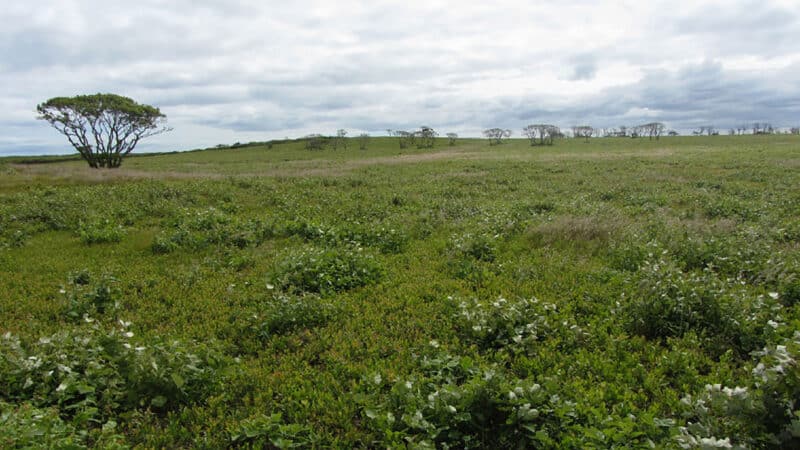by Dr. Sarah Treanor Bois, PhD
Director of Research & Education at the Linda Loring Nature Foundation
Driving around the south of the island, you may be headed to the beach or just going on a traditional Nantucket “rantum scoot.” Most dirt roads headed to the shore take you past open landscapes of waving grasses, low shrubs, and wildflowers when the season is right. Head of the Plains, Smooth Hummocks, Cisco— these are sandplain grasslands and coastal heathlands. On Nantucket, we’re pretty lucky: the sandplain grasslands here are some of the largest remaining intact grasslands of their kind in the world.
Because of their unique nature and special status, island conservation organizations have been working hard to protect, manage, and expand these habitats where possible. To enhance these efforts, in 2016 the Sandplain Grassland Network was formed. This network brings together grassland managers, researchers, and practitioners throughout the sandplain grassland distribution range. Massachusetts boasts the largest amount of remaining Sandplain Grassland habitat, primarily found on Nantucket and Martha’s Vineyard. However, small pockets exist on Cape Cod, in southern Maine, coastal Connecticut, and Long Island. The network shares knowledge of sandplain grassland management, focusing on lessons learned and on problems encountered. The result of this work is a new paper recently published in the Journal of Restoration Ecology summarizing the status of this globally rare sandplain grassland habitat throughout its range.
Sandplain Grasslands of the northeastern U.S. are iconic hotspots for biodiversity and important conservation priorities because of their relative rarity, limited geographical range, and the diversity of uncommon plant and animal species that they support. Numerous state- and federally-listed plant species occur in sandplain habitats. The habitat also supports listed grassland-specialist birds and lepidoptera (moths and butterflies). Supporting the overall habitat also protects these important species.
Sandplain Grassland habitats have been managed by conservation groups and agencies for decades. As early successional habitats, they require some kind of disturbance to be maintained. In a “natural setting,” without human intervention, that disturbance may be in the form of periodic wildfires, wind and salt spray, and grazing by mammals. Land managers mimic these disturbances with prescribed fire, mowing or brush hogging, selective species removal, tree cutting, and combinations of all of these treatments to maintain and encourage grassland species.
While many of these actions have worked historically to treat grasslands, there has been growing concern from land managers about the lack of success in recent years. Problems include increasing woody plant encroachment, more and new non-native invasive species, and changes in the ability to use certain management techniques.
The recent paper is the result of the Sandplain Grassland Network working to bring together these concerns and offer solutions: it’s a blueprint for future actions. It’s also important to the authors, myself included, that the information be open and accessible for anyone to utilize. The network performed a literature review of both published and unpublished reports along with interviews with land managers from across the region. It was determined that our management efforts need to expand in order to reduce woody plant cover that is impacting rare species and driving succession. While we have made good progress in the shortterm and have learned a great deal about these habitats, management is currently not adequate to maintain this system over the long-term considering both current conditions and the implications of climate change.
The network worked through 242 sources of literature (published and unpublished) and interviewed 31 practitioners about their experiences managing and working in Sandplain Grasslands. The interviews were an important component since many people working with these habitats have in-house, internal knowledge and publishing their knowledge or making it otherwise available wasn’t always a priority. It was important to the Sandplain Grassland Network and to the future of management, to record this knowledge and make the information broadly available before people retired and moved on. Managers can learn from their predecessors’ experience and use it as a baseline for the future.
Recommendations for Sandplain Grassland management include experimenting with different combinations of management techniques including prescribed fire, mowing, and direct removal of woody plants to reduce the amount of woody cover which is limiting grasses and wildflowers.
“We need to manage these habitats more intensively than we have done in the past,” said Dr. Chris Neill, an Ecosystem Ecologist with the Woodwell Climate Research Center. “Climate change will also be a challenge as managers will have to consider species movement, changes in precipitation, and impacts on management techniques such as prescribed fire.”
In addition to the recommendations for current management, the network outlines future challenges Sandplain Grasslands are facing. The paper highlights knowledge gaps and areas for new research, making it a great place to start for those looking for new projects. These include looking at how the foundational species of these grassland communities are responding to climate change. With warming temperatures and changing precipitation, how species respond will ultimately influence how the ecosystem will fare in the near future. Other indirect impacts of climate change include limitations in the use of prescribed fire, since climate change impacts make using fire during the growing season more unpredictable. New and experimental methods of soil disturbance are also discussed.
Both the Nantucket Conservation Foundation and the Linda Loring Nature Foundation are local founding members of the Sandplain Grassland Network and are co-authors on the paper. Much of the research and experts interviewed are based on Nantucket or had previously worked in our Sandplain Grasslands.
So while the beaches are the highlight for many visiting Nantucket, our grasslands are where the real excitement is. To read the paper, the full manuscript is currently available “early access” at the Journal of Restoration Ecology.
To learn more about Sandplain Grasslands locally, visit your favorite conservation organizations. The Sandplain Grassland Network has greatly facilitated information sharing and collaboration for this important biodiversity hotspot. To learn more about the Sandplain Grassland Network visit sandplaingrassland.net.



